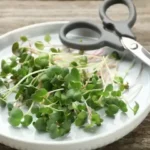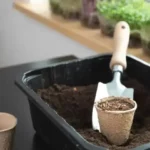As your microgreens flourish, you find yourself at a crossroads in your gardening endeavors. You yearn for that ideal balance of sweetness, freshness, and maximum nutritional benefits of your delicate crop, but uncertainty lingers. How do you know when to harvest microgreens?
In search of guidance, you turn to the vast realm of information, hoping to unlock the secrets of harvesting microgreens. Today, we dig into this journey together. We uncover the signs and cues that will empower you to harvest your microgreens at the pinnacle of perfection, allowing you to savor their vibrant flavors and elevate your culinary creations to new heights.
Generally, it’s best to harvest microgreens when true leaves appear, which typically takes 7 to 14 days for optimal flavor, nutrition, and regrowth. Remember that sanitation and clean tools ensure quality, so harvest your greens using a sharp knife or micro pruners about an inch above the base, leaving the roots for maximum yield.
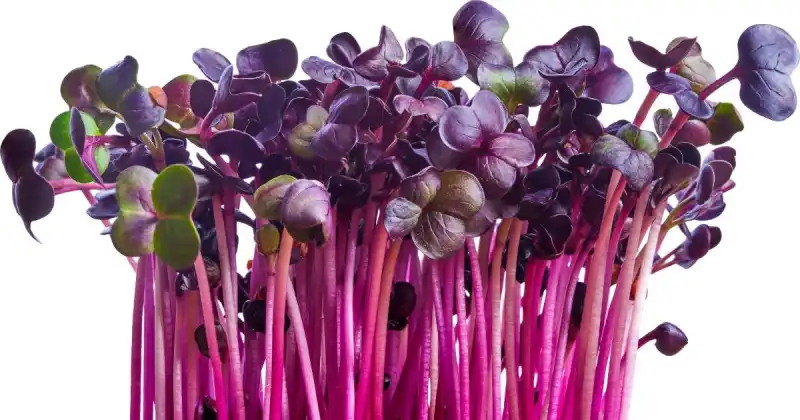
As you embark on this exciting green adventure, prepare to discover the art of timely harvesting, regrowth’s allure, and proper harvesting techniques. From understanding the signs of readiness to wielding your scissors or micro pruners with precision, every step is an invitation to uncover the full potential of these nutrient-packed yet tiny greens.
Join me as we delve into the fascinating world of microgreens, where freshness meets flavor, nourishment spurs creativity, and your culinary journey takes on a whole new dimension.
Humble Highlights
- Save time by discovering the three benefits of timely harvesting your microgreens so you can enhance vibrant harvests and grow with confidence.
- Stop throwing cash in the trash with these 3 insider signs that your greens are ready for harvest so you can pick them at the peak of freshness and quality!
- Discover these unusual microgreen varieties that require full and low light to reach their maximum potential to offer your greens the best growing environment for taste and quality.
Benefits Of Timely Harvesting Your Microgreens
By timely harvesting microgreens, you maximize their flavor, nutritional value, and, in some varieties, maximize potential for multiple harvests. Harvesting ensures you experience microgreens’ best qualities, enhancing your culinary creations and promoting a healthy diet. Several excellent benefits of timely harvesting include:
- Maximizing Flavor
- Nutrient Density
- Extended Harvests

Flavor Maximization
Microgreens are known for their concentrated flavors and unique and fresh taste profiles. Therefore, harvesting them at the right time ensures you enjoy the best flavor experience. Overly mature micros may become bitter or lose their delicate flavors. Conversely, if your plants are cut early, it may result in an underdeveloped taste. 1
Nutritious Contents
As microgreens grow, their nutrient levels increase, so harvesting them when they have reached their peak growth and maturity allows you to obtain the most nutrients from each serving. Typical microgreen nutrients include protein, lysine, thiamine, niacin, calcium, potassium, iron, manganese, zinc, and copper, and they are a good source of vitamins A and C and folate. 2
Some microgreen varieties grow best when cut down right after the first leaves grow and not at their peak. Thus, observe your flourishing crop, take note of its appearance, and sample a small amount for taste and texture.
Extended Harvests
Although only several microgreen varieties have the potential for regrowth, timely harvesting often encourages the process. By cutting the microgreens one inch above the soil line, some types, like wheatgrass, can grow back and provide a second or third harvest. This way, you get the maximum yield and extend the availability of fresh microgreens from the same batch, saving time and money.
Microgreens Grow Fast: Signs They Are Ready For Harvest
There are a few specific signs that your greens are ready for harvest, including:
- Visual Cues
- Tactile Cues
- Sensory Cues

Visual Cues (cotyledon development, leaf size)
When you’re greens are ready for harvest, one of the best visual signs is the development of their first true leaves. These leaves appear as the second set after the initial seed leaves, known as cotyledons.
When assessing the readiness of microgreens, consider their size. Microgreens range in size from approximately 1 to 3 inches (2.5 to 7.5 cm) in length.
Tactile Cues (firmness, resistance)
Tactile cues involve touching and feeling the microgreens to assess their readiness for harvest. Gently brush the leaves and feel their firmness. When ready to be harvested, micros will have a certain level of firmness and resistance. If they feel too soft or fragile, it may indicate that they are still in the early stages of growth and need more time before harvesting. 3
On the other hand, feeling excessively tough or woody could mean that they have matured beyond the ideal harvest point.
Sensory Cues (aroma, taste)
Sensory cues involve using your senses of smell and taste to determine if these tiny greens are ready for harvest. When ready, they often have a distinct aroma that can be pleasing and indicate their flavor profile. Take a whiff and see if they have a noticeable scent. Additionally, consider sampling a small portion of your crop to assess its flavor.
Can You Wait Too Long To Harvest Microgreens
Because different varieties of microgreens have unique requirements, it depends on what you’re growing. Microgreens are tastiest when harvested during the seed leaf stage, also called the first set of leaves or cotyledon stage, and before the second set of leaves, called true leaves, appear on the plant.
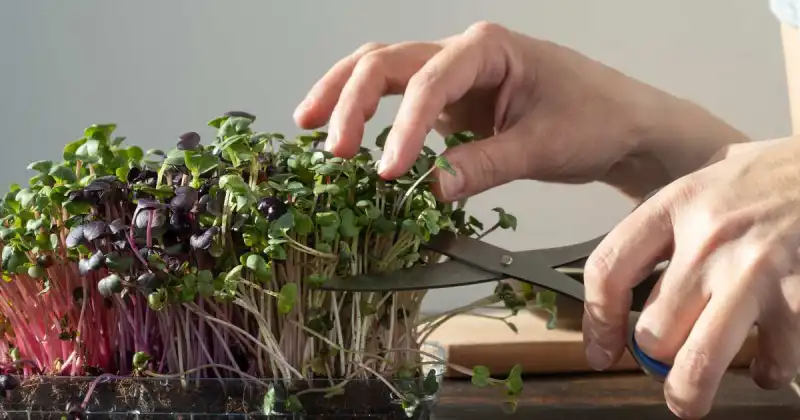
The leaves contain more beneficial plant compounds during this early growth stage, resulting in sweeter and more flavorful microgreens. If you wait until these leaves have fully grown, your microgreens may grow larger and taller, but they could also become slightly bitter and chewy. 4
Sampling microgreens before harvesting is essential because not all generalizations about taste and texture apply universally. Some taste better when harvested at the true leaf stage. For example, mustard greens are milder, while lettuce varieties are less bitter at this stage.
Knowing when to harvest your microgreens may sound like a daunting task, but it is actually quite easy. As the video below expertly details, there are three primary things you’ll be looking for come harvest time: microgreen height, taste, and if the plant’s true leaves are present.
Storing Microgreens: Brushing Microgreen Seed Hulls
When it comes to storing microgreens, one crucial step is to remove any remaining seed hulls. Seed hulls, called seed coats or shells, resemble the sturdy armor surrounding the delicate seed. They keep the tiny plant inside safe and provide essential nutrients as it germinates and grows.

Once the seed starts to sprout, the hulls usually crack open or fall off, allowing the young seedling to come out and continue growing. However, some remain affixed to the tops of your pants. You can gently shake or brush your crop with your hand to help loosen the remaining hulls, ensuring a cleaner and more presentable final product. Likewise, you can carefully spray the top canopy of your greens with water to do the same. 5
Afterward, when drying the microgreens on a rack, paper towel, or colander, you can fluff them up to ensure they’re nice and orderly, helping your tiny plants dry evenly.
Microgreens With Higher Light Needs And Their Ideal Harvest Time
Growing your microgreens at home means ensuring they get the required amount of light, whether natural or artificial grow lights. Lights are needed after the initial germination period during the blackout phase, when you intentionally block out any light, or when leaves start sprouting from the seeds.
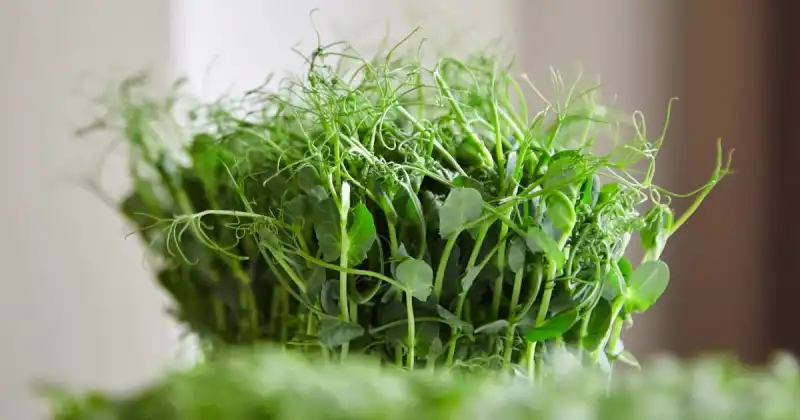
Most microgreen gardeners use grow lights as these can be controlled manually and adjusted as needed since different microgreens have different lighting demands. Below are lists of popular plants grown as microgreens.
Sunflower
- Light needs: Sunflower microgreens grow best in bright, indirect light. They can tolerate some direct sunlight but may require protection from intense heat.
- Ideal harvest time: When they are around 10-14 days old or reach a height of approximately 4-6 inches.
Pea Microgreens
- Light needs: These greens prefer moderate to high light levels but can tolerate partial shade.
- Ideal harvest time: When they are around 10-14 days old or reach a height of 2-3 inches. 6
Broccoli, Radish, Mustard
- Light needs: These varieties thrive in bright, indirect light environments and can even tolerate some direct sunlight. Adequate light exposure enables them to photosynthesize efficiently.
- Ideal harvest time: When they are around 8-12 days old or reach a height of 1-2 inches.
Arugula, Amaranth, Beet, Kale, Salad Mix, Speckled Pea
- Light needs: Require moderate to high light levels. They grow well in bright, indirect light and can tolerate some direct sunlight.
- Ideal harvest time: When they are around 8-12 days old or reach a height of 2-4 inches.
Basil, Carrots
- Light needs: These greens enjoy moderate to high light levels with a fair amount of brightness. Place them in a spot where they can receive plenty of indirect sunlight or bright light throughout the day. They don’t mind some direct sunlight either, as long as it’s not too intense or scorching.
- Ideal harvest time: When they are around 10-14 days old or have developed their first true leaves.

Pea Shoots
- Light needs: Pea shoots require moderate to high light levels. They grow well in bright, indirect light and can tolerate some direct sunlight.
- Ideal harvest time: These microgreens are ready to harvest when they have developed many leaves and are around 4-8 inches tall. 7
Microgreens With Lower Light Needs
Aside from microgreens that enjoy moderate to high light levels, some varieties thrive in lower shades and intensities.
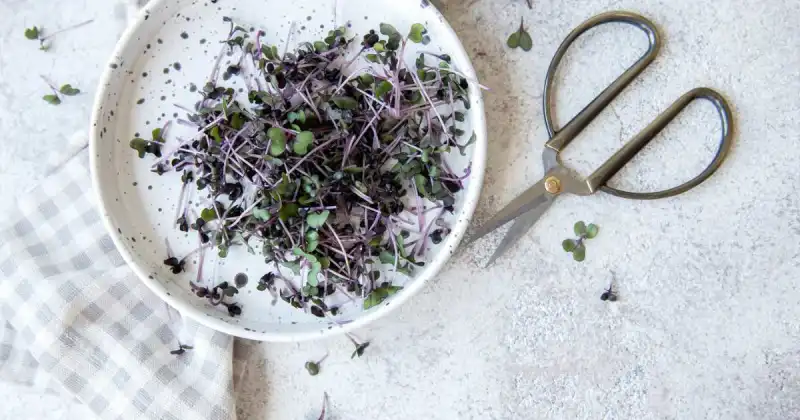
Cilantro, Chia, Lentil, Purslane
- Light needs: These microgreens have adapted to lower light conditions and can still grow and develop their distinctive flavors and textures without intense light exposure.
- Ideal harvest time: When they are around 10-14 days old or have developed their first true leaves.
Alfalfa, Mung Bean
- Light needs: These unique greens have evolved to use available light efficiently, allowing them to grow and reach their full potential with less intense light than other varieties.
- Ideal harvest time: When they are around 8-12 days old or reach a height of 2-4 inches. 8
Cutting Microgreens Properly
To harvest microgreens properly, gently grab the greens, including the stems, and position your scissors, micro pruners, or knife one inch from the surface. It’s essential to ensure your cutting tool is clean and sharp to avoid squeezing, crushing, or breaking your delicate microgreens, as this can hasten their decomposition and potentially spread disease. Make a clean cut with a quick and precise motion, separating them from the base of the plant and growing medium.

By cutting the microgreens just above the soil line, you can harvest the portion you want while leaving the roots and any remaining growth undisturbed. This process allows your microgreens to grow another batch and makes removing them from the tray easier. 9
Microgreens Regrow After Cutting: Fact Or Fiction
Some microgreens can regrow after the initial harvest. When you harvest microgreens by cutting them just above the soil, specific types can regrow and give you another batch. However, not all microgreens have this ability.
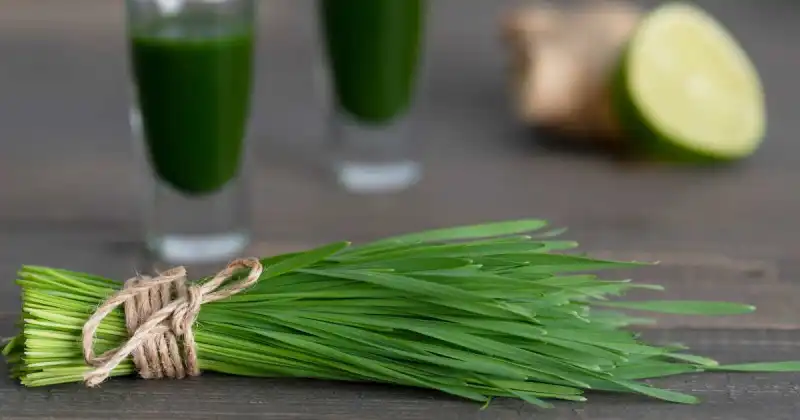
Microgreens like kale, arugula, radish, cilantro, and basil are several varieties that can grow back. After you cut them, they can produce new shoots from the base of the remaining stem, which provides another opportunity for additional harvests. 10
However, there are downsides to trying to regrow your microgreens, such as an increased risk of mold and other types of contamination. In commercial microgreens, it is generally not practical due to the time, quality, and resources involved. Instead, it is more efficient to discard the roots and soil from the previous batch and start fresh with new microgreens seeds and soil, as it only takes a week or so for a new crop to be harvest-ready.
By focusing on growing a new batch of microgreens, you can utilize your energy and space more effectively, ensuring a higher-quality and safer harvest.
Typically, the four primary microgreens that traditionally regrow are beans, peas, wheatgrass, and salad greens – but only if you harvest them correctly. Although second and third crops may be slightly less flavorful and nutrient-dense, cut above the last set of leaves on the stem to achieve multiple harvests. By doing so, plants retain their ability to photosynthesize to continue generating energy and growth.
Conclusion
Knowing when to harvest microgreens is a crucial skill that can significantly affect your harvest’s flavor, texture, and overall quality. By mastering the art of recognizing the visual cues of cotyledon development, feeling the satisfying firmness and resistance, and delighting in the enticing aromas and flavors, you become the green conductor of a symphony of freshness and vibrant nourishment.
To grow efficiently, it’s also best to determine the quality of light your microgreens need to be harvested and enjoyed as quickly as possible. Varieties like pea, sunflower, broccoli, kale, salad mix, and radish flourish in moderate to high light levels, while cilantro, lentil, alfalfa, and mung bean enjoy lower shades.
Remember, while some specific microgreens can regrow, most do not. Therefore, unless cultivating a green that has demonstrated, time and again, to regrow, like wheatgrass, pea, beans, and salad greens, it’s best to start over with a new batch to avoid possible mold growth and contamination.
So, join the adventure of harvesting microgreens and unlock their never-ending potential, infusing your dishes with an explosion of color, taste, and health-giving vitality that will leave you craving more.
Do you currently grow microgreens at home? We’d love to hear about your success – and a tip or two you can share with your fellow growers. Take a moment to drop us a line in the comments section below!
SOURCES
- Oregon State University, Extension Service – Get Big Flavor From Tiny Microgreens
- ResearchGate – Microgreen Nutrition, Food Safety, And Shelf Life: A Review
- Mississippi State University, Extension – Grow Microgreens Inside For Fresh Winter Produce
- United States Department Of Agriculture – Specialty Greens Pack A Nutritional Punch
- Wikipedia – Microgreen
- National Library Of Medicine, National Center For Biotechnology Information – Light Spectrum Differently Affects The Yield And Phytochemical Content Of Microgreen Vegetables In A Plant Factory
- Frontiers – Continuous Lighting Can Improve Yield And Reduce Energy Costs While Increasing Or Maintaining Nutritional Contents Of Microgreens
- MDPI – The Inclusion Of Green Light In A Red And Blue Light Background Impact The Growth And Functional Quality Of Vegetable And Flower Microgreen Species
- Louisiana State University, Extension – Microgreens: A Guide To Growing Microgreens For The Home Gardener
- United States Department Of Agriculture – Microgreens Go From Trendy Vegetables To Functional Food


